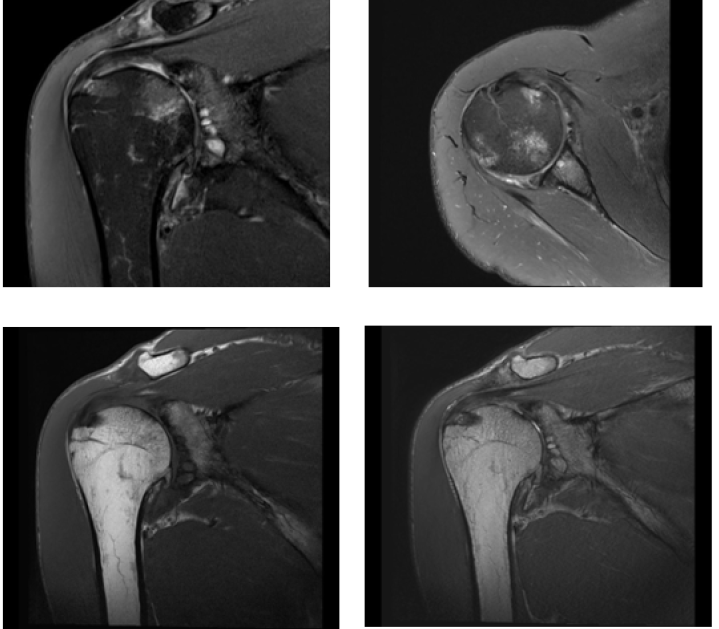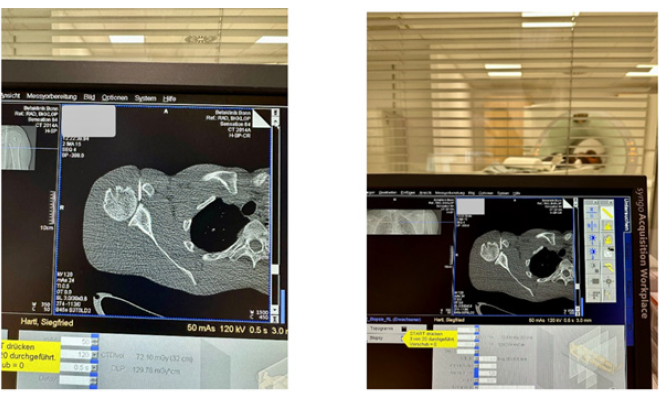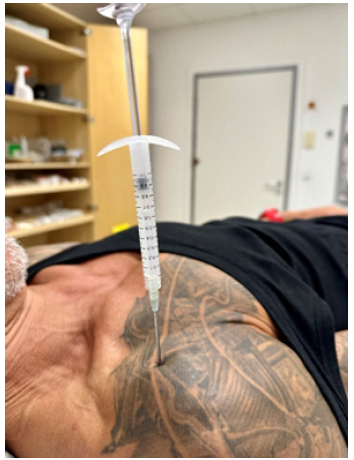- Submissions

Full Text
Advancements in Case Studies
Arthrosamid Offers a New Therapeutic Approach in the Treatment of Omarthrosis
Klingenberg M*
Beta Clinic, Bonn, Germany
*Corresponding author:Markus Klingenberg, Beta Clinic, Bonn, Germany
Submission:February 08, 2024;Published: February 22, 2024

ISSN 2639-0531Volume4 Issue2
Abstract
The successful pain-relieving treatment of highly symptomatic osteoarthritis in a national karate coach with Arthrosamid is described in this case report. This type of treatment had previously only been used in cases of gonarthrosis. The extensive conservative and arthroscopic treatment that had previously been carried out had not resulted in a sustained reduction in pain. A single off-label injection of 3 ml of a 2.5% polyacrylamide hydrogel (Arthrosamid) was administered. The injection was performed under CT guidance. A significant analgesic effect occurred rapidly and was long lasting. A follow-up MRI scan did not reveal any structural changes. If the manufacturer’s instructions are followed, Arthrosamid represents a therapeutic option for the treatment of advanced osteoarthritis. A prerequisite for the therapy is that the joint capsule and the rotator cuff are intact so that Arthrosamid can have an effect in the affected joint. A single course of oral antibiotics is a prophylactic measure immediately prior to injection.
Keywords:Intra-articular treatment; Ostoarthritis; 2.5% polyacrylamide hydrogel; Omarthrosis
Abbreviations: PAAG: Polyacrylamide Hydrogel; ACP: Autologous Conditioned Plasma
Introduction
Non-surgical management of advanced shoulder osteoarthritis with high physical demands can be challenging for both patient and physician. The majority of injections are often only able to provide moderate and very limited pain relief in cases of severe osteoarthritis. In this case, after exhaustion of extensive conservative treatment, the patient underwent off-label treatment with 2.5% polyacrylamide hydrogel (Arthrosamid). This is a non-biodegradable hydrogel that integrates into the synovium of the joint capsule. Studies have shown that a single injection can provide sustained pain relief and improved joint function in osteoarthritis of the knee.
Case Presentation
The patient, aged 57, is a professional karate coach for the German National Team. The patient reported severe pain in his right shoulder on exertion at his initial consultation in July 2023. Using the visual analogue scales (VAS 1 to 10), he reported pain of 8 to 10. The patient’s shoulder is subject to high loads. The patient is right-handed. The range of motion of the right shoulder was within the normal range but was slightly reduced in comparison to the left shoulder. Range of motion: flexion 170°, abduction 180°, external rotation/internal rotation in abduction 80°-0-50°. The examination of the cervical spine was found to be normal. An ultrasound examination of the shoulder showed an intact rotator cuff and no relevant joint effusion. The acromioclavicular joint was free of irritation.
Pre-treatment included external arthroscopy with subacromial decompression, bursectomy and chondroplasty on (25/02/2020). The most recent MRI scan (2020) showed a fourth degree omarthrosis. Extensive conservative therapies were performed in addition to physiotherapy and targeted self-exercise. Cortisone injections, hyaluronic acid injections and NSAIDs were used (Figure 1).
Figure 1:MRI findings of the right shoulder (January 2024).

After a comprehensive physical examination and assessment of the available findings, the patient received three CT-guided injections of ACP and collagen into the right shoulder over a twomonth period. Following this treatment, the patient reported an improvement of approximately 50% in pain on effort to VAS 4-5. Shoulder mobility was unchanged.
In October 2023, the patient underwent a clinical examination and an updated magnetic resonance imaging (MRI) scan of the right shoulder. Compared with the preliminary MRI images from 2020, the findings of a grade 4 glenohumeral omarthrosis with an intact rotator cuff were virtually unchanged. The limited range of motion in the lateral comparison is explained by the osteophytes. With the exception of the reduced external rotation of 80° in the abduction position, the patient showed a normal and equal mobility of the shoulder on both sides.
Due to the extensive cartilage damage in the humerus and the glenoid cavity, regenerative surgical methods of treatment were not promising. The patient declined arthroplasty. Due to potential side effects, long-term use of analgesics is not recommended. The patient’s discipline and compliance with exercise and dietary recommendations was excellent. After a detailed consultation, a review of the therapeutic options and the exclusion of possible contraindications, a single off-label treatment with Arthrosamid (PAAG) was carried out. This was done under CT guidance as with the previous injections (Figure 2 &3).
The manufacturer’s instructions for use were followed. This included prophylactic antibiotic treatment. A total of 3ml of Arthrosamid was injected, was injected, which is 50% of the recommended dose for the knee joint. The injection was well tolerated by the patient. There was a significant improvement in the patient’s symptoms within two weeks. The patient’s symptoms improved significantly within two weeks, with a 90% improvement to a VAS of 1, and remained at a low level for four months, despite heavy physical activity. No significant structural changes were seen on a subsequent MRI in January 2024.
Figure 2:Intra-articular infiltration of Arthrosamid

Figure 3:CT-guided intra-articular injection.

Discussion
The treatment of osteoarthritis with PAAG is different from conventional methods such as hyaluronic acid, platelet-rich plasma (PRP) and regenerative stem cell therapy. PAAG is a non-degradable hydrogel that is incorporated into the soft synovial tissue of the joint capsule, where it provides lubrication and cushioning [1-3].
The literature has demonstrated the efficacy of PAAG in the treatment of osteoarthritis of the knee [4-7]. After one year of treatment, PAAG was found to be more effective than hyaluronic acid therapy in patients under the age of 70 years. Furthermore, when followed for three years, PAAG demonstrated improved WOMAC scores [8].
In this case, a 3ml volume of PAAG (Arthrosamid) was used. This was a 50% reduction compared to the 6ml volume used for the treatment of gonarthrosis. The patient had previously received larger volumes as part of her PRP therapy, which meant that the 6 ml volume could be used in case of need. The rapid onset of the pain-relieving effect is consistent with experience in the knee joint area [4-7].
For the therapy to be effective, the joint capsule and rotator cuff must be intact. This allows Arthrosamid to work in the affected joint. This case suggests that, provided the contraindications and precautions are observed, Arthrosamid (PAAG) can be used to treat osteoarthritis of other large joints.
Conclusion
This case report demonstrates that Arthrosamid (Polyacrylamide hydrogel) provides a novel therapeutic approach for treating advanced omarthrosis with an intact rotator cuff. Future endoprosthetic treatment remains possible..
Acknowledgment
MRI images courtesy of Dr. med. André Demant.
Conflict of Interest
There is no conflict of interest.
References
- Jorge L Escobar Ivirico, Maumita Bhattacharjee, Emmanuel Kuyinu, Lakshmi S Nair, Cato T Laurencin (2017) Regenerative engineering for knee osteoarthritis treatment: biomaterials and cell-based technologies. Engineering 3(1): 16-27.
- Christensen L, Daugaard S (2016) Histological appearance of the synovial membrane after treatment of knee osteoarthritis with polyacrylamide gel injections: A case report. Journal of Arthritis 5: 217.
- Christensen L, Camitz L, Illigen KE, Hansen M, Sarvaa R, et al. (2016) Synovial incorporation of polyacrylamide hydrogel after injection into normal and osteoarthritic animal joints. Osteoarthritis Cartilage 24(11): 1999-2002.
- Henriksen M, Overgaard A, Hartkopp A, Bliddal H (2018) Intra-articular 2.5% polyacrylamide hydrogel for the treatment of knee osteoarthritis: an observational proof-of-concept cohort study. Clin Exp Rheumatol 36(6): 1082-1085.
- Goldman DT, Piechowiak R, Nissman D, Bagla S, Isaacson A (2018) Current concepts and future directions of minimally invasive treatment for knee pain. Current Rheumatology Reports 20(9): 54.
- Bliddal H, Overgaard A, Hartkopp A, Beier J, Conaghan PG, et al. (2021) Polyacrylamide hydrogel injection for knee osteoarthritis: A 6months prospective study. J Orthop Res Ther 6(2): 1188.
- Tnibar A, Schougaard H, Camitz L, Rasmussen J, Koene M, et al. (2015) An international multi-centre prospective study on the efficacy of an intraarticular polyacrylamide hydrogel in horses with osteoarthritis: A 24months follow-up. Acta veterinaria Scandinavica 57(1): 20.
- 3-year results for Arthrosamid® from the IDA extension study presented at OARSI World Congress. A study presented at the Osteoarthritis Research Society International (OARSI) World Congress, in Denver (Colorado, USA) from 17-20th March 2023.
© 2024 Klingenberg M. This is an open access article distributed under the terms of the Creative Commons Attribution License , which permits unrestricted use, distribution, and build upon your work non-commercially.
 a Creative Commons Attribution 4.0 International License. Based on a work at www.crimsonpublishers.com.
Best viewed in
a Creative Commons Attribution 4.0 International License. Based on a work at www.crimsonpublishers.com.
Best viewed in 





.jpg)






























 Editorial Board Registrations
Editorial Board Registrations Submit your Article
Submit your Article Refer a Friend
Refer a Friend Advertise With Us
Advertise With Us
.jpg)






.jpg)














.bmp)
.jpg)
.png)
.jpg)










.jpg)






.png)

.png)



.png)






